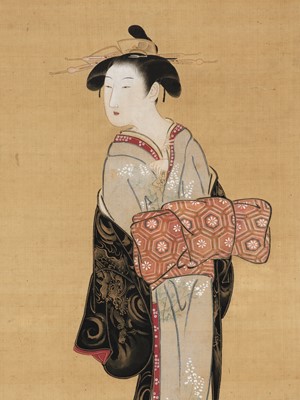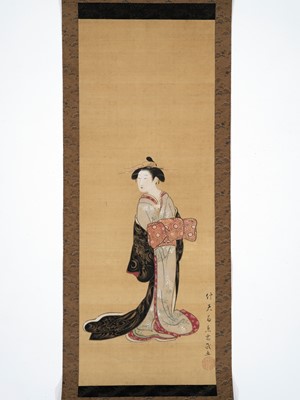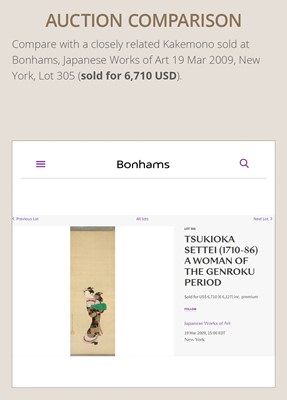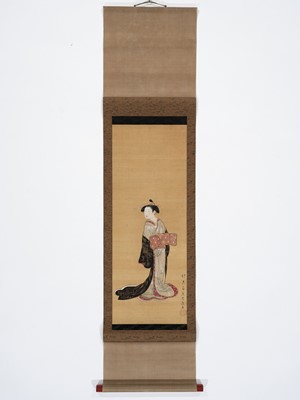16th Jun, 2023 11:00
Fine Japanese Art
75
TSUKIOKA SETTEI: A KAKEMONO OF A COURTESAN
Sold for €2,600
including Buyer's Premium
Tsukioka Settei (1726-1786), signed Shinten’o oju giga
Japan, late 18th century, Edo period (1615-1868)
Very finely painted with ink, gouache, gold, and watercolors on silk, mounted as a hanging scroll on a finely woven and embroidered silk brocade frame with lacquer handles. Depicting a courtesan wearing voluminous robes decorated with flower motifs, and a gold dragon embroidered black Haori coat, posed alone against a blank background. The red cuffs and hems provide the only bright spots of color. The courtesan depicted is from the high-ranking Oiran class. Her obi (kimono sahs) is tied at the front which is seen in the Kansai region of pleasure quarters.
Signed and inscribed to the lower right with seal: 信天翁應需戯画 “Shinten’o oju giga” (Painted on commission with a light spirit by Shinten’o).
The Seal: 姓源、氏木田、名昌信、字大渓、号雪鼎、初号月岡、自称、信天翁。
“Sei Minamoto, uji Kida, na Masanobu, aza Daikei, go Settei, hatsugo Tsukioka jisho Shinten’o” (The honorary surname Minamoto, family name Kida; alternative names: Masanobu, Daikei, Settei, Tsukioka, personal art name Shinten’o)
SIZE (image) 86.5 x 30.3 cm, 154 x 37.5 cm (including mounting)
Condition: Very good condition with minor traces of wear and age and few small touch-ups.
Provenance: Family collection of either Felix Tikotin (1893-1986) or his son-in-law Louis (Loek) Borensztajn (1935-2021), Netherlands.
Felix Tikotin (1893-1986) was an architect, art collector, dealer, and founder of the first Museum of Japanese Art in the Middle East. He became one of the world’s leading collectors of Japanese art, starting at the age of 18, and continued to collect and work as an art dealer in Berlin in the 1920s. In the 1930s Felix Tikotin fled from the Nazis and hid his collection in the Netherlands. After the war, he decided that his collection should be taken to Israel, where in 1959 and with the help of Abba Hushi, who was the mayor of Haifa, The Tikotin Museum of Japanese Art was established. The Museum's collection comprises more than 8,000 items of art and crafts.
Tsukioka Settei (1726-1786) was a prominent Japanese painter and print artist known for his exquisite depictions of beauties, particularly courtesans and geishas, in grand and elegant robes. He studied under Takada Keiho of the Kyoto Kano school, and his early works reflected the influence of Nishikawa Sukenobu. Settei's artistic talent blossomed, and he designed over fifty illustrated books, many of which depicted the manners and customs of women from historical eras. He gradually developed his own style and began to paint hanging scrolls of contemporary beauties, for which he is most renowned. His works featured bold patterning, intricate details, and the use of high-quality pigments, with red outlines on faces and limbs being a distinctive feature. Settei's paintings and prints also included erotica of refined technical skill. In about An'ei 1 (1772), Settei was elevated to the rank of Hogen, which he often used in his signature. His son, Sessai, and other pupils continued his artistic legacy, emulating his style in their works.
Auction comparison:
Compare with a closely related Kakemono sold at Bonhams, Japanese Works of Art 19 Mar 2009, New York, Lot 305 (sold for 6,710 USD).
A restrained composition is one that is minimalistic, simplified, and carefully arranged to achieve a sense of balance and harmony. It often employs a limited color palette, simple shapes, and a deliberate use of negative space to convey a sense of calmness and order. A restrained composition is typically characterized by a lack of excessive detail, ornamentation, or unnecessary elements, creating a sense of understated elegance and refinement. It can be seen in various forms of visual arts, including painting, photography, and graphic design.
Tsukioka Settei (1726-1786), signed Shinten’o oju giga
Japan, late 18th century, Edo period (1615-1868)
Very finely painted with ink, gouache, gold, and watercolors on silk, mounted as a hanging scroll on a finely woven and embroidered silk brocade frame with lacquer handles. Depicting a courtesan wearing voluminous robes decorated with flower motifs, and a gold dragon embroidered black Haori coat, posed alone against a blank background. The red cuffs and hems provide the only bright spots of color. The courtesan depicted is from the high-ranking Oiran class. Her obi (kimono sahs) is tied at the front which is seen in the Kansai region of pleasure quarters.
Signed and inscribed to the lower right with seal: 信天翁應需戯画 “Shinten’o oju giga” (Painted on commission with a light spirit by Shinten’o).
The Seal: 姓源、氏木田、名昌信、字大渓、号雪鼎、初号月岡、自称、信天翁。
“Sei Minamoto, uji Kida, na Masanobu, aza Daikei, go Settei, hatsugo Tsukioka jisho Shinten’o” (The honorary surname Minamoto, family name Kida; alternative names: Masanobu, Daikei, Settei, Tsukioka, personal art name Shinten’o)
SIZE (image) 86.5 x 30.3 cm, 154 x 37.5 cm (including mounting)
Condition: Very good condition with minor traces of wear and age and few small touch-ups.
Provenance: Family collection of either Felix Tikotin (1893-1986) or his son-in-law Louis (Loek) Borensztajn (1935-2021), Netherlands.
Felix Tikotin (1893-1986) was an architect, art collector, dealer, and founder of the first Museum of Japanese Art in the Middle East. He became one of the world’s leading collectors of Japanese art, starting at the age of 18, and continued to collect and work as an art dealer in Berlin in the 1920s. In the 1930s Felix Tikotin fled from the Nazis and hid his collection in the Netherlands. After the war, he decided that his collection should be taken to Israel, where in 1959 and with the help of Abba Hushi, who was the mayor of Haifa, The Tikotin Museum of Japanese Art was established. The Museum's collection comprises more than 8,000 items of art and crafts.
Tsukioka Settei (1726-1786) was a prominent Japanese painter and print artist known for his exquisite depictions of beauties, particularly courtesans and geishas, in grand and elegant robes. He studied under Takada Keiho of the Kyoto Kano school, and his early works reflected the influence of Nishikawa Sukenobu. Settei's artistic talent blossomed, and he designed over fifty illustrated books, many of which depicted the manners and customs of women from historical eras. He gradually developed his own style and began to paint hanging scrolls of contemporary beauties, for which he is most renowned. His works featured bold patterning, intricate details, and the use of high-quality pigments, with red outlines on faces and limbs being a distinctive feature. Settei's paintings and prints also included erotica of refined technical skill. In about An'ei 1 (1772), Settei was elevated to the rank of Hogen, which he often used in his signature. His son, Sessai, and other pupils continued his artistic legacy, emulating his style in their works.
Auction comparison:
Compare with a closely related Kakemono sold at Bonhams, Japanese Works of Art 19 Mar 2009, New York, Lot 305 (sold for 6,710 USD).
A restrained composition is one that is minimalistic, simplified, and carefully arranged to achieve a sense of balance and harmony. It often employs a limited color palette, simple shapes, and a deliberate use of negative space to convey a sense of calmness and order. A restrained composition is typically characterized by a lack of excessive detail, ornamentation, or unnecessary elements, creating a sense of understated elegance and refinement. It can be seen in various forms of visual arts, including painting, photography, and graphic design.
Zacke Live Online Bidding
Our online bidding platform makes it easier than ever to bid in our auctions! When you bid through our website, you can take advantage of our premium buyer's terms without incurring any additional online bidding surcharges.
To bid live online, you'll need to create an online account. Once your account is created and your identity is verified, you can register to bid in an auction up to 12 hours before the auction begins.
Intended Spend and Bid Limits
When you register to bid in an online auction, you will need to share your intended maximum spending budget for the auction. We will then review your intended spend and set a bid limit for you. Once you have pre-registered for a live online auction, you can see your intended spend and bid limit by going to 'Account Settings' and clicking on 'Live Bidding Registrations'.
Your bid limit will be the maximum amount you can bid during the auction. Your bid limit is for the hammer price and is not affected by the buyer’s premium and VAT. For example, if you have a bid limit of €1,000 and place two winning bids for €300 and €200, then you will only be able to bid €500 for the rest of the auction. If you try to place a bid that is higher than €500, you will not be able to do so.
Online Absentee and Telephone Bids
You can now leave absentee and telephone bids on our website!
Absentee Bidding
Once you've created an account and your identity is verified, you can leave your absentee bid directly on the lot page. We will contact you when your bids have been confirmed.
Telephone Bidding
Once you've created an account and your identity is verified, you can leave telephone bids online. We will contact you when your bids have been confirmed.
Classic Absentee and Telephone Bidding Form
You can still submit absentee and telephone bids by email or fax if you prefer. Simply fill out the Absentee Bidding/Telephone bidding form and return it to us by email at office@zacke.at or by fax at +43 (1) 532 04 52 20. You can download the PDF from our Upcoming Auctions page.
How-To Guides
How to Create Your Personal Zacke Account
How to Register to Bid on Zacke Live
How to Leave Absentee Bids Online
How to Leave Telephone Bids Online
中文版本的操作指南
创建新账号
注册Zacke Live在线直播竞拍(免平台费)
缺席投标和电话投标
Third-Party Bidding
We partner with best-in-class third-party partners to make it easy for you to bid online in the channel of your choice. Please note that if you bid with one of our third-party online partners, then there will be a live bidding surcharge on top of your final purchase price. You can find all of our fees here. Here's a full list of our third-party partners:
- 51 Bid Live
- EpaiLive
- ArtFoxLive
- Invaluable
- LiveAuctioneers
- the-saleroom
- lot-tissimo
- Drouot
Please note that we place different auctions on different platforms. For example, in general, we only place Chinese art auctions on 51 Bid Live.
Bidding in Person
You must register to bid in person and will be assigned a paddle at the auction. Please contact us at office@zacke.at or +43 (1) 532 04 52 for the latest local health and safety guidelines.







